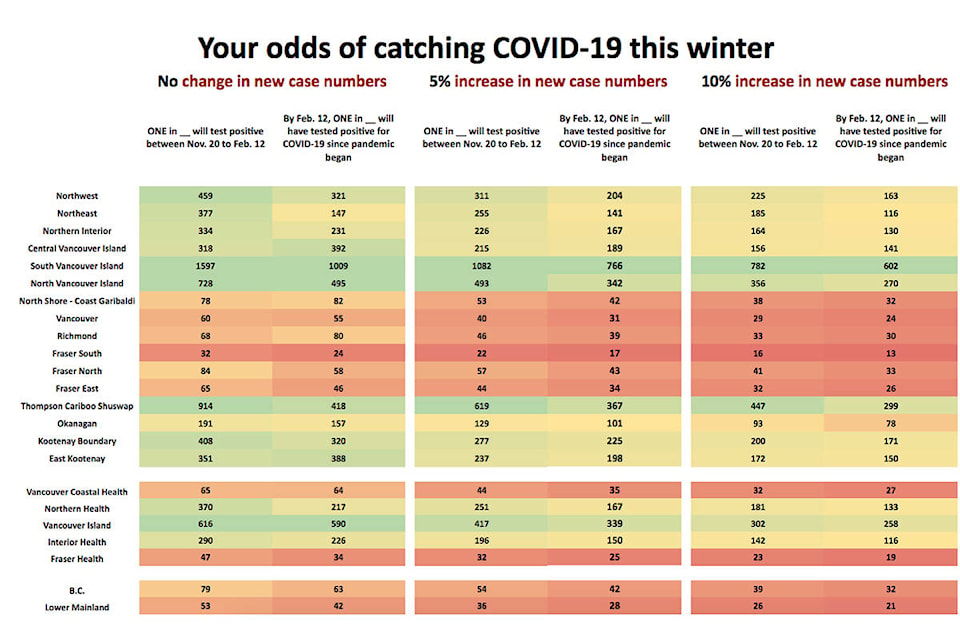By mid-February, one in 53 Lower Mainland residents will be diagnosed with COVID-19 over the next 12 weeks if the current number of new case numbers hold. And if case counts continue to rise at even a fraction of their current rates, those odds will shorten dramatically, an analysis by The News shows.
(The positivity rate, which are the odds of someone who is being tested is unrelated to this analysis. These are odds are for any person residing in the Lower Mainland having a confirmed case of COVID-19.)
By mid-February, at a 10 per cent rate of increase, one in 21 Lower Mainland residents, and one in 32 British Columbians will have been diagnosed with COVID-19 since the pandemic began. If the past six months are any indication, more are likely to have acquired the virus but not know they have done so. One in 13 residents in the Fraser South region (Delta, Surrey, White Rock and Langley) will have had a confirmed case of COVID-19 if case numbers increase by 10 per cent each week.
Between Nov. 13 and 19, there were 4,500 confirmed cases of the virus in the Fraser Health and Vancouver Coastal Health regions. At that rate of new infections, 45,000 people will be diagnosed with COVID-19 by mid-February. Cases are also rising elsewhere, with every part of B.C. seeing significant increases in the number of confirmed cases.
If new case counts keep climbing – even modestly – it will become much more likely that one acquires COVID-19. The average person’s odds of being diagnosed with COVID-19 positive over the next 12 weeks will double if case numbers climb by even just 10 per cent per week. That 10 per cent number would actually require the rate of the virus’s spread has slowed. Since the start of October, new case numbers have grown at an average rate exceeding 30 per cent.)
Click the + button in the top-left of the image below to enlarge
The figures underscore the danger of an unchecked virus’s tendency towards exponential growth and the need to reverse recent trends. Similarly to the dangers posed by increasing numbers, if the number of new case counts decreases by 10 per cent each week, the number of people who are diagnosed with COVID-19 by February will be cut in half.
But if new case counts don’t increase and just remain level, the odds are good that most people know someone who will acquire the virus over the coming weeks.
At current case rates, by Feb. 12, one in 24 residents of the Fraser South region (Delta, Surrey, White Rock and Langley) will have confirmed COVID-19 diagnoses – including those who have already been infected. The figures don’t account for any missed cases that don’t result in a positive diagnosis.
Elsewhere in the Lower Mainland, odds of infection by Feb. 12 would range from one in 46 in Fraser East to one in 80 in Richmond.
In the Okanagan, one in 157 people would have been diagnosed; in Northern B.C. one in 217 people would have had confirmed cases, and on Vancouver Island, there would be about one case for every 600 people.
Across B.C., about one in 80 people will test positive for the virus over the next 12 weeks if case counts stop rising.
Do you have something to add to this story, or something else we should report on? Email:
tolsen@abbynews.com
